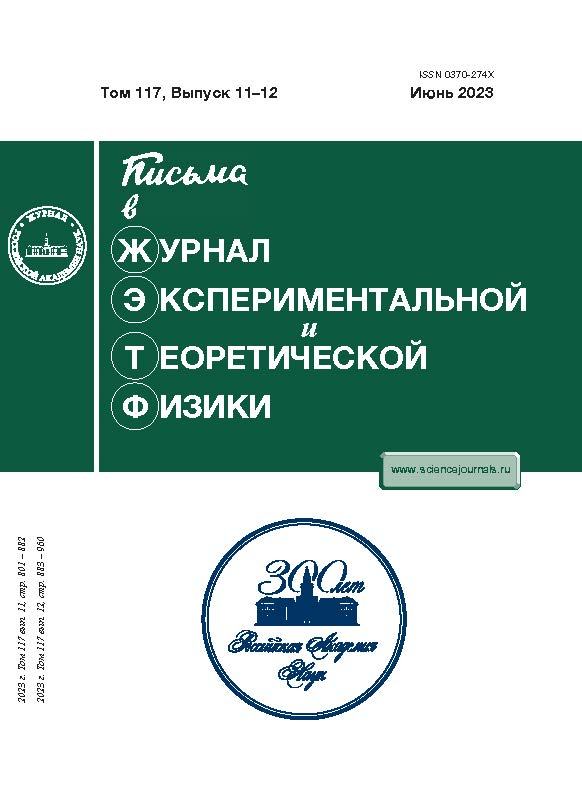Energy Spectrum of the Valence Band in HgTe Quantum Wells on the Way from a Two- to Three-Dimensional Topological Insulator
- 作者: Min'kov G.M1,2, Rut O.E3, Sherstobitov A.A3,2, Dvoretskiy S.A4,3, Mikhaylov N.N4,3, Aleshkin V.Y.5
-
隶属关系:
- Ural Federal University, 620000, Yekaterinburg, Russia
- Mikheev Institute of Metal Physics, Ural Branch, Russian Academy of Sciences, 620137, Yekaterinburg, Russia
- Novosibirsk State University, 630090, Novosibirsk, Russia
- Rzhanov Institute of Semiconductor Physics, Siberian Branch, Russian Academy of Sciences, 630090, Novosibirsk, Russia
- Institute for Physics of Microstructures, Russian Academy of Sciences, 603087, Afonino, Nizhny Novgorod region, Russia
- 期: 卷 117, 编号 11-12 (6) (2023)
- 页面: 912-918
- 栏目: Articles
- URL: https://rjonco.com/0370-274X/article/view/663160
- DOI: https://doi.org/10.31857/S1234567823120078
- EDN: https://elibrary.ru/EWBPKJ
- ID: 663160
如何引用文章
详细
The magnetic field and temperature dependences of longitudinal magnetoresistance and the Hall effect have been measured in order to determine the energy spectrum of the valence band in HgTe quantum wells with the width dQW = 20–200 nm. The comparison of hole densities determined from the period of Shubnikov–de Haas oscillations and the Hall effect shows that states at the top of the valence band are doubly degenerate in the entire dQW range, and the cyclotron mass
determined from the temperature dependence of the amplitude of Shubnikov–de Haas oscillation increases monotonically from
to
(
is the mass of the free electron) with increasing hole density
from
to
cm–2. The determined dependence has been compared to theoretical dependences
calculated within the four-band kP model. These calculations predict an approximate stepwise increase in
owing to the pairwise merging of side extrema with increasing hole density, which should be observed at
and 4 × 1010 cm–2 for dQW = 20 and 200 nm, respectively. The experimental dependences are strongly inconsistent with this prediction. It has been shown that the inclusion of additional factors (electric field in the quantum well, strain) does not remove the contradiction between the experiment and theory. Consequently, it is doubtful that the mentioned kP calculations adequately describe the valence band at all dQW values.
作者简介
G. Min'kov
Ural Federal University, 620000, Yekaterinburg, Russia; Mikheev Institute of Metal Physics, Ural Branch, Russian Academy of Sciences, 620137, Yekaterinburg, Russia
Email: grigori.minkov@urfu.ru
O. Rut
Novosibirsk State University, 630090, Novosibirsk, Russia
Email: grigori.minkov@urfu.ru
A. Sherstobitov
Novosibirsk State University, 630090, Novosibirsk, Russia; Mikheev Institute of Metal Physics, Ural Branch, Russian Academy of Sciences, 620137, Yekaterinburg, Russia
Email: grigori.minkov@urfu.ru
S. Dvoretskiy
Rzhanov Institute of Semiconductor Physics, Siberian Branch, Russian Academy of Sciences, 630090, Novosibirsk, Russia; Novosibirsk State University, 630090, Novosibirsk, Russia
Email: grigori.minkov@urfu.ru
N. Mikhaylov
Rzhanov Institute of Semiconductor Physics, Siberian Branch, Russian Academy of Sciences, 630090, Novosibirsk, Russia; Novosibirsk State University, 630090, Novosibirsk, Russia
Email: grigori.minkov@urfu.ru
V. Aleshkin
Institute for Physics of Microstructures, Russian Academy of Sciences, 603087, Afonino, Nizhny Novgorod region, Russia
编辑信件的主要联系方式.
Email: grigori.minkov@urfu.ru
参考
- L. G. Gerchikov and A. Subashiev, Phys. Status Solidi b 160, 443 (1990).
- X. C. Zhang, A. Pfeu er-Jeschke, K. Ortner, V. Hock, H. Buhmann, C. R. Becker, and G. Landwehr, Phys. Rev. B 63, 245305 (2001).
- E. G. Novik, A. Pfeu er-Jeschke, T. Jungwirth, V. Latussek, C. R. Becker, G. Landwehr, H. Buhmann, and L. W. Molenkamp, Phys. Rev. B 72, 035321 (2005).
- Y. Ren, Z. Qiao, and Q. Niu, Rep. Progr. Phys. 79(6), 066501 (2016); doi: 10.1088/0034-4885/79/6/066501.
- C. R. Becker, V. Latussek, G. Landwehr, and L. W. Molenkamp, Phys. Rev. B 68, 035202 (2003).
- S. Dvoretsky, N. Mikhailov, Yu. Sidorov, V. Shvets, S. Danilov, B. Wittman, and S. Ganichev, ElectronicMaterials 39, 918 (2010).
- G. Landwehr, J. Gerschu¨tz, S. Oehling, A. Pfeu er-Jeschke, V. Latussek, and C. R. Becker, Physica E 6, 713 (2000).
- X. C. Zhang, A. Pfeu er-Jeschke, K. Ortner, C. R. Becker, and G. Landwehr, Phys. Rev. B 65, 045324 (2002).
- K. Ortner, X. C. Zhang, A. Pfeu er-Jeschke, C. R. Becker, G. Landwehr, and L. W. Molenkamp, Phys. Rev. B 66, 075322 (2002).
- Z. D. Kvon, E. B. Olshanetsky, E. G. Novik, D. A. Kozlov, N. N. Mikhailov, I. O. Parm, and S. A. Dvoretsky, Phys. Rev. B 83, 193304 (2011).
- X. C. Zhang, A. Pfeu er-Jeschke, K. Ortner, V. Hock, H. Buhmann, C. R. Becker, and G. Landwehr, Phys. Rev. B 63, 245305 (2001).
- M. S. Zholudev, A. V. Ikonnikov, F. Teppe, M. Orlita, K. V. Maremyanin, K. E. Spirin, V. I. Gavrilenko, W. Knap, S. A. Dvoretskiy, and N. N. Mihailov, Nanoscale Res. Lett. 7, 534 (2012).
- G. M. Minkov, V. Ya. Aleshkin, O. E.Rut, A. A. Sherstobitov, A. V. Germanenko, S. A. Dvoretski, and N. N. Mikhailov, Physica E 116, 113742 (2020)
- E. L. Ivchenko, Optical Spectroscopy of Semiconductor Nanostructures, Alpha Science International, Harrow, UK (2005), p. 427.
- З. Д. Квоn, М. Л. Савченко, Д. А. Козлов, Е. Б. Ольшанецкий, А. С. Ярошевич, Н. Н. Михайлов, Письма в ЖЭТФ 112(3), 174 (2020).
- А. Ю. Кунцевич, Е. В. Тупиков, С. А. Дворецкий, Н. Н. Михайлов, М. Резников, Письма в ЖЭТФ 111(11), 750 (2020).
- G. M. Minkov, A. V. Germanenko, O. E.Rut, A. A. Sherstobitov, M. O. Nestoklon, S. A. Dvoretski, and N. N. Mikhailov, Phys. Rev. B 93, 155304 (2016).
- G. M. Minkov, V. Ya. Aleshkin, O. E.Rut, A. A. Sherstobitov, A. V. Germanenko, S. A. Dvoretski, and N. N. Mikhailov, Phys. Rev. B 96, 035310 (2017).
补充文件









